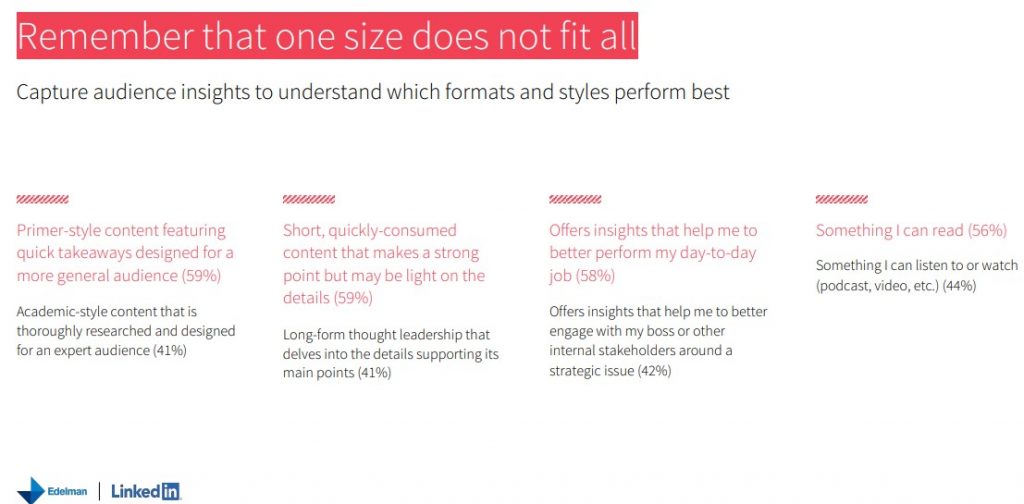 Since the start of the pandemic, content has flooded digital channels trying to gain the attention of self-reliant buyers. The noise is deafening. And much of the B2B content produced is leaving buyers cold.
Since the start of the pandemic, content has flooded digital channels trying to gain the attention of self-reliant buyers. The noise is deafening. And much of the B2B content produced is leaving buyers cold.
Edelman and LinkedIn recently released the 2021 B2B Thought Leadership Impact Study.
Their findings gave me pause. We often think of thought leadership as somewhat of a specialty format of content. Like Pillar content or content designed to drive “lead” gen. But, as I reviewed the findings in the report, I noticed many of the findings apply not just to thought leadership content, but to all B2B content.
The below graphic from the study shows preferences that are applicable for any content development project. In fact, I don’t relate at least two of these points strictly to thought leadership content.

For example, consider the two in the middle:
- “Short, quickly consumed content that makes a strong point but may be light on the details.” (59%) I’d think this would fall short of thought leadership by just making a point but not providing the rest of the story.
- “Offer insights that help me to better perform my day-to-day job” (58%) also seems to fall a bit short. This falls into the realm of “how-to” content that wouldn’t normally apply to thought leadership content.
Likewise, the things that leave buyers wanting are similar in this report as in other buyer preferences studies, including (by order of importance):
- Overly focused on selling rather than conveying valuable information
- Authored by people who are not subject matter experts
- Too staid or corporate in style
- Unoriginal thinking or lacking new ideas
- Meager evidence or lack of supporting data for the arguments
The second one related to subject matter experts is the only one that applies more to thought leadership than other types of content in marketing’s arsenal.
Use POV to Win Engagement for Your B2B Content
Just as in a recent post I wrote about format vs. relevance, relevance (as interpreted by the buyer) wins out again. I’d contend that all the content your marketing team produces needs to be human, be helpful, and be insightful. And the report found that only 19% of buyers appreciate content that validates their current thinking. Read that again…
Point of View (POV) is about taking a stand. No wishy-washy, sort-of-making-a-point content. Put a stake in the ground and build on it. Tell your audience what you think. Don’t beat around the bush. Make it firm and then support it with evidence and reasoning. Challenge the status quo.
POV should also support your brand positioning and messaging. What does your company think? Does it think so consistently? What does it stand for and believe? POV only works if you don’t waver.
Much of the B2B content published today talks about what research thinks or what the industry thinks. Very little of it takes a stand about what the company producing it thinks. And, if they do, there’s weak or no support for their perspective.
And this doesn’t mean it needs to be research. It could be customer opinion or testimonials. It could be what your subject matter experts think. Or it could be what your end users say on review sites. It could also tie back to trends under discussion in the industry. There are lots of possibilities for supporting evidence.
POV Builds Affinity…Or Not
The other outcome from POV is that it makes your content/company memorable. If your content is just a repetition of what everyone else in the industry is saying, there’s no differentiation. But, when you take a stand and stick with it in relation to a topic or problem your audience cares about, it sticks with them.
The consistency of repeating and expanding on the “stand” you take serves as the stickiness that attaches the idea to your buyers’ memory. This means it’s not discarded as “already known” and saved as new information related to your brand.
The reason? Because a strong POV evokes emotion. You’re not shooting for straddling the middle of the road. You’re shooting for affinity or avoidance. They’ll either love you or hate you. Like is so meh.
What this does is serve as a filter for those who will never become your customers. Or if they do, they’ll be the unhappy ones because your cultures don’t align.
POV plays a role in driving affinity. You attract the people who believe what you believe…or want to. And you filter out the people who won’t ever buy from you, just waste your sales reps’ time.
A few other advantages that come with a strong POV:
- Your audience is more likely to share your content
- They’ll talk about it with other stakeholders
- They’ll bring your ideas into meetings
And if your storytelling around the POV is stellar, they’ll make those stories their own and put themselves in the hero’s role.
And finally, 87% of buyers say that thought leadership (read all content) can be both intellectual and fun to consume at the same time.
There’s a big upside that comes with POV. Fortunately for you, not many companies have one that’s provocative or memorable. So, get after it!
Leave a Reply